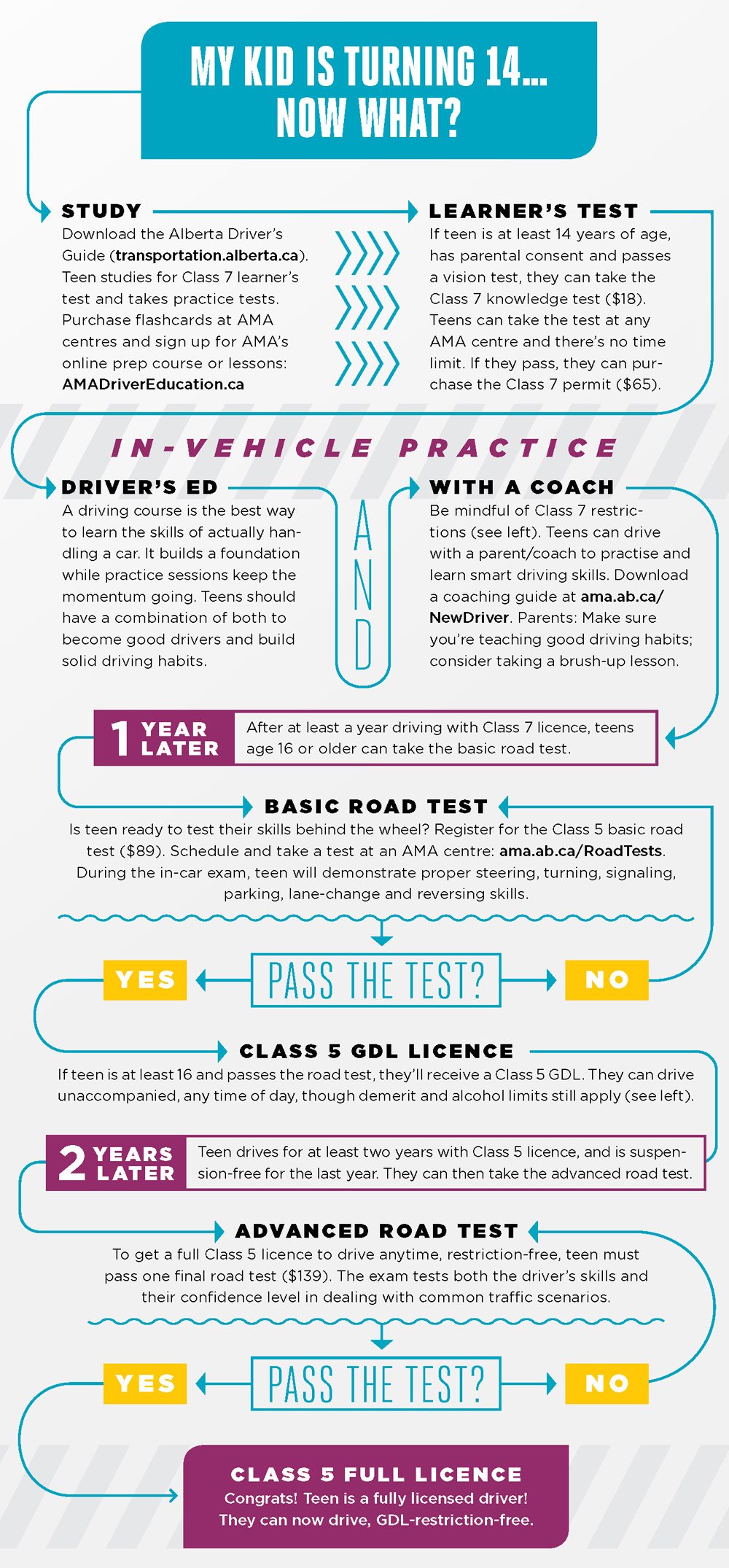Handing the keys to your teen: For you, it’s a jumbled mix of excitement, pride—and worry. For her, it’s freedom and a rite of passage into adulthood.
“I couldn’t wait to get my licence!” says Brynn Trofimuk, reflecting on her driving journey. “I lived on an acreage outside of Edmonton, so I was always on quads and dirt bikes growing up,” she says. “I was also a competitive gymnast and I didn’t want to wait for my mom or take the bus to get to practice.”
Like many teens, Trofimuk, now 20, counted down the days to her 14th birthday, when she could finally write her Class 7 learner’s test. But unlike some teens, she actually waited about six months before writing the test. “I wanted to study and make sure I was ready so I could get it right the first time, which I did.”
Trofimuk’s prep time appears to be the exception to the rule: “A lot of students try to write the test without even cracking the handbook—and they ultimately fail,” says Rick Lang of AMA Driver Education. AMA offers a range of classes at every step of the driving journey, from a two-hour learner’s prep course to the Ultimate Program with 20-hours of in-car training.
“Five percent of driving is in the hands and feet,” Lang says. “The other 95 percent of driving takes place between the ears—which is where driver education comes in.” AMA Driver Education teaches hands-on decision-making to would-be drivers. Specially trained in-car instructors help students identify situations and teach them the best course of action to take—in real time behind the wheel.
After hours of practice with the instructor and their parents or in-car coach, that driving decision-making becomes second nature. “Many people can master the five percent, but it’s the other 95 percent that makes a good driver,” Lang says.
MORE TO READ
Why you should learn to drive in winter
Trofimuk signed up for AMA Driver Education immediately after getting her Class 7 learner’s licence. “I wasn’t nervous behind the wheel, but I didn’t fully understand why you should do certain things,” she explains. Take lane changes, for instance. “I was terrible at them! I didn’t get how or why I should use my mirrors. Then one day, after several practice sessions, it just clicked. Parallel parking was also challenging. I wasn’t awful at it, but it took a lot of practice—and it paid off since I passed that part of my Class 5 road test on the first try.” She hasn’t looked back since.
Trofimuk put her licence to good use on a cross-country road trip to New Brunswick with her mom to start her first year of university. She now drives daily and plans to take her Class 5 advanced road test this summer.
For young drivers like her, the biggest takeaway from driver education is confidence in their driving skills. “Our goal is to make sure students know how to drive properly,” Lang says. “So they become safe drivers for life.”
HOW TO BE A COACH
In addition to a driving course, new drivers should also get 30 to 50 hours of in-vehicle coaching. Try these tips from AMA driver educator Rick Lang:
• Keep it short for the first few coaching sessions. After about 15 minutes, patience wears thin for teens and parents.
• Set out to practise one skill during each session.
• Ask your young driver to communicate what he plans to do before he does it. It’ll let you evaluate his decision-making skills and driving aptitude.
• Don’t stick to parking lots. New drivers need real-world situations and must develop road-scanning skills under real conditions.
• Sign kids up for driver education in the winter. If they learn in an Alberta winter, driving in spring and summer will be a breeze.
• Lastly, don’t pass along your own bad driving habits: Could you pass a road test if you took it today? If not, sign-up for a refresher course before taking your teen driving.

TESTING, TESTING, 1, 2, 3
With 30 years of transportation experience as a driving instructor, policymaker and examiner, Steven Lee knows his way around a road test. The senior driver examiner with D-Tec Driver Testing shares a few insider tips for young drivers and their parents.
Who do road test examiners work for?
We are independent contractors licensed by Alberta’s Ministry of Transportation; we go through rigorous training and monitoring by the Government of Alberta. But we’re independent—we are not dedicated to any one registry in the province.
How many basic road tests do you administer in an average week?
I typically do about 10 tests each day, which translates to about five or six hours a day. So in an average week, I probably conduct about 50 exams.
Are there better times than others to schedule a test?
Not really. I tell teens that it doesn’t matter when you take the exam because you will have to drive in those conditions, at those times, at some point.
What kind of vehicle should young drivers use for the test?
Whatever they are most comfortable driving, be it a compact car or a pickup truck from the farm. The important thing is to make sure it’s in good working order: fully functioning signals, brake lights and headlights, a crack-free windshield and operational horns.
MORE TO READ
How to prepare for your Class 5 road test in Alberta
Which driving skills do you test?
We check if they have good control of the vehicle and know how to handle it. Then we see if they know how to execute certain driving skills and procedures, like parking, reversing and turning. Finally, we make sure they know the rules of the road and are not committing any violations. Certain violations, such as a collision or traffic ticket, will result in immediate failure.
What are the most common mistakes people make?
Getting too nervous. Nerves cause stress and lead to mistakes. The key is to stay calm and focus. Reversing and parking can be challenging: Kids get a bit scared when you even say the phrase “parallel parking,” so I try not to say it. Instead, I ask them to back up behind that car or line up beside that curb.
How do you handle a driver who fails?
I don’t use the word “fail.” I might say to a driver they haven’t been successful this time and they need a bit more practice. Then I go through the driving checklist and point out the mistakes they made and discuss how to correct them. I also ask if they would like me to review the checklist with their parents, so they can help coach them.
Any other advice for young drivers?
I like to tell teens to stick to CPR: Concentrate, practice and relax. That’s all they really need for driving success.
THE NEW-DRIVER JOURNEY
Alberta’s Graduated Driver Licencing (GDL) program has been in place since 2003. Here’s how it works:
Class 7: Learner’s Licence
At age 14, teens can take the 30-point multiple-choice exam that tests knowledge of driving skills, road rules and signs. It can be taken at any AMA centre. Pass by getting at least 25 questions correct and obtain a Class 7 learner’s licence. Teens can then drive when accompanied by a fully licensed driver 18 years of age or older. Other restrictions: no driving from midnight to 5 a.m., zero alcohol level behind the wheel and 8-demerit points (vs. 15 for licensed drivers).
Class 5: Probationary GDL
After one year driving with a Class 7, drivers at least 16 years of age can schedule the Class 5 road test. It’s a good idea to take driver’s ed during that year. During the in-car test, teens must demonstrate solid driving skills, including parking, turning, reversing and lane changes. Pass, and a Class 5 probationary licence will be issued, allowing teens to drive unaccompanied any time of day (demerit and alcohol limits are the same as Class 7).
Class 5: Full Licence
Drive Class 5 for two years (the last one suspension-free), and complete and pass an advanced road test. This class increases the demerit points one can amass before licence suspension, removes the zero-alcohol condition and permits you to accompany a learner driver.
WE’RE HERE FOR YOU
Let AMA Driver Education teach you the skills to feel confident behind the wheel—and keep you safely on the road.

